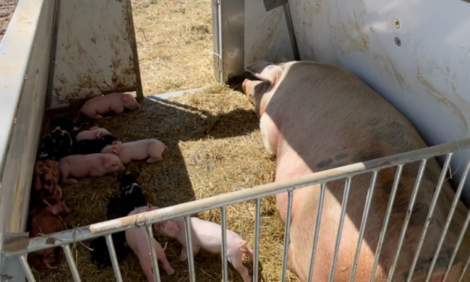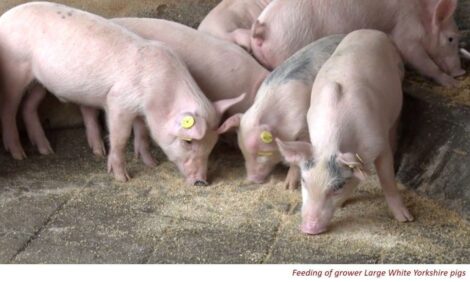



Livestock Price Outlook - July 2003
By Chris Hurt - This report was issued following the USDA's Quarterly Hogs and Pigs Report. Pork producers can look forward to the next 18 months with some optimism as costs are expected to drop and hog prices are expected to remain at least high enough to cover all expenses. This is great news for many producers needing to improve their relationship with their lenders after about 14 months of operating losses.
Summary
 Chris Hurt
Chris HurtExtension Economist Purdue University |
Leading the improvement will be lower feed costs and higher hog prices resulting from declining
pork production as a result of reductions of the breeding herd. Costs are expected to drop about $2 per live hundredweight by this fall due to lower corn and soybean meal prices. Pork supplies will be down an estimated 2 to 3 percent for the remainder of this year. In addition to reductions in pork supplies, hog prices will be supported by a recovering general economy and by weakness of the U.S. dollar in relation to the Canadian dollar.
Prices for 51 to 52 perccent lean animals on a live weight basis are expected to average near $41 over the next 12 months with the higher prices occurring this summer and again next spring and summer. Historical hog cycle patterns suggest that the breeding herd could continue to decline throughout 2003, and that prices and profits in 2004 may be more favorable than is now indicated.
The Numbers
The breeding herd continues to decline as producers responded to discouraging prices and lack of
profits over the past 14 months. The breeding herd on June 1 was estimated by USDA at 5.9 million animals, a reduction of over four percent from the same period last year. This is the fourth quarterly report indicating that the breeding herd is declining. Further declines are expected though all of 2003 so that pork supplies will continue to decline through much of 2004.
Producers in most midwestern states have reduced their breeding herds. The decline was led by
Missouri with 11 percent fewer animals in the breeding herd, but closely followed by Iowa and Ohio with an 8 percent reduction.
Illinois’ herd was down 7 percent, Indiana down 6 percent, and Nebraska was down 5 percent. These six states accounted for a reduction of 225,000 animals in the breeding herd, with the national total down 269,000.
The breeding herd increased by 9 percent in Oklahoma, 5 percent in Texas, 4 percent in South
Dakota, and 2 percent in Minnesota.
Colorado provides an interesting study of the boom/bust cycles created during the structural
revolution of the past 15 years, and of failed opportunities and massive loss of capital as
environmental restrictions made the state less desirable for hog production. In the past year an
additional 20 percent, or 30,000 animals, have been eliminated from the Coloradeo breeding
herd.
Traditionally, the state was a minor producer of hogs. In 1984, for example, there were only
20,000 animals in the state’s breeding herd. As hog corporations began to look to the western
U.S. for sites, a revolution occurred over the next 15 years. The number of sows doubled to
40,000 by 1990, doubled again to 80,000 in just 3 more years (1993). Numbers doubled again in
another four years (160,000 by 1997), and reached a 210,000 peak in December of 1999. Today,
the breeding herd stands at only 120,000 head, a drop of 43 percent in the past 3.5 years.
If one assumes that $2,000 per sow was invested in facilities in Colorado, the decline of 90,000 sows represents about $180 million of capital investment someone has walked away from. Boom/bust
cycles are always costly in a market economy, and the Colorado hog industry is a clear example.
Supplies of hogs should be down about 2 to 3 percent this summer and 3 percent lower in the fall, according to the number of animals in various weight categories. There is an indication that producers will not cut back on farrowings as much as they had indicated in March. Producers say they will reduce their summer farrowings by only 2 percent, after indicating a 3 percent reduction in March.
For fall 2003 farrowings, they have indicated only a one percent reduction. If producers
follow through on these intentions, pork supplies next winter and in the spring of 2004 would be
moderately lower than in 2003.
Small Drop in Supply: Big Price Increase
Pork supplies should continue to moderate throughout 2003 and into 2004. Summer pork production
is expected to be down 2 percent and fall production down by nearly 3 percent (Table 4). Weights
are expected to be up by nearly one percent over the coming 12 month period. For the year of 2003, slaughter is expected to be down by nearly 2 percent, to 98.4 million head. Weights are expected to be .8 percent higher with total pork production down about 1 percent, to 19.4 billion pounds.
As has been discussed at length in past issues of this report, hog prices have become superresponsive to modest changes in supplies and 2003 is no exception. With just a 1.3 percent reduction in pork production, a 15 percent higher price for this year compared to 2002 is expected. Last year, 51 to 52 percent lean hogs, on a live weight basis, averaged $34.29. This year’s projection is for hogs to average $40.31.
Prices are expected to average in the low to mid-$40s, during the summer and drop to the higher
$30s for a fall quarter average. Prices are anticipated to average near $40 for the winter and back into the low-to-mid $40s for the spring of 2004 (Table 5).
How Many Canadian Hogs?
The number of pigs born in Canada but moved to the U.S. for finishing has continued to expand.
In the first four months of the year for which data are currently available, the number of pigs imported from Canada totaled at 1.5 million head, 22 percent more than during the same period last year.
There was some corresponding offset in the number slaughter ready animals being imported,
but total imports from Canada were still up 5 percent so far this year. Canadian hogs have
represented 6.2 percent of the hogs slaughtered in the U.S. this year.
In the past three years, as an example, the growth of Canadian hog imports has muted the price
impact of smaller production in the U.S. In 2000, total slaughter was 97.9 million, with 94.0 million produced in the U.S. and 3.9 million from Canada, and prices averaged $44.70. In 2003, the U.S. has reduced production to 92.3 million, but the number of Canadian hogs is expected to rise to 6.1 million such that the total number of hogs will be near 98.4 million. While this number is close to the number slaughtered in 2000, prices will average about $40 rather than near $45.
One of the driving economic forces has been the strong U.S. dollar, providing incentives for Canadian producers to sell hogs in the U.S. However, since late in 2002, the U.S. dollar has dropped by 15 percent in relation to the Canadian dollar. Today, the Canadian dollar is at about the same exchange rate relative to the U.S. dollar as in 1996. This will reduce the incentive to move pigs and hogs to the U.S., but there will be a delay in seeing the impact as most of the pigs coming from Canada to the United States are on coordinated contracts.
Mad cow disease in Canada has likely provided some support for hog prices in the U.S. The
restriction of live cattle and beef imports from Canada to the United States has increased U.S.
beef prices. As beef prices rise, there is some substitution effect as some consumers shift from
higher priced beef to more moderate priced pork. These cross effects, however, are thought to
be small.
Positive Returns to Continue
Costs of production are expected to moderate in the coming 12 month period as interest rates
continue to be very low and feed prices fall. Costs for farrow to finish operations were estimated to have reached about $40.50 per live hundredweight in the second quarter of 2003. Moderating corn and soybean meal prices are expected to reduce production costs to about $38 for the final quarter of the year, based on $.35 per bushel lower corn prices and $20 per ton lower soybean meal prices.
Projected cost for the next 12 months is about $38.70 with expected revenues about $2.00 higher, providing a slim margin above total costs on average across the period. The best periods of profits are expected to be this summer and the late-spring and summer of 2004, with winter prices near breakeven, Figure 1. These returns will give producers the opportunity to begin to improve their financial position after about 14 months of losses experienced from March of 2002 through April of 2003.

Implications for the Industry
Prospects for positive cash flows mean that progress can be made on weakened financial
positions. While a period of large profits cannot be forecast from the current level of herd
liquidation, observations on past hog cycles suggest that the ultimate reduction in the herd may be larger than is being suggested now and that prices and profits will be greater than is now in view.
For example, from the calendar quarter of the largest losses on the cycle, it is generally about 6 to 8 quarters until the highest profit period occurs. In the cycles observed back to 1980, profits reached at least $10 per live hundredweight in the most profitable quarters. The largest losses on the current cycle were during the fourth quarter of 2002. Adding 6 to 8 quarters to this provides a “best estimate” with the highest returns coming around the spring of 2004 through the fall of 2004.
To achieve $10 or greater per live hundredweight margins will require hog prices in the higher
$40s and above. Currently, futures for June 2004 are reflecting live prices several dollars lower than this. This would seem to leave room for futures prices to increase, at least for that time period. Again, there is the chance that 2004 could be a very good profit year so that producers should be a bit slow to hedge hog prices this far ahead. However, many hog producers need to keep their price risk low and will find profitable hedging opportunities as far out as 18 months.
Another factor that will likely improve the outlook for hog prices in the coming year is an improving U.S. and world economy. In the Survey of Professional Forecasters conducted by the Federal Reserve Bank of Philadelphia, economists are now suggesting that the economy will begin to grow at a rate of 3.4 to 4.0 percent over the next 12 months. They estimate that unemployment will finally begin to drop late this year and continue to decline through 2004.
Also, world economic growth is expected to expand by 3 percent in 2004 compared to only 2
percent this year. Further, our four largest pork purchasing countries (Japan, Mexico, Canada,
and South Korea) are all expected to have sizable improvements in their economic growth rates
which should help spur exports.
Finally the decline of the U.S. dollar relative to the Canadian dollar will have positive impacts on hog prices in 2004. On the other hand, the dollar has stayed relatively stable in relationship to the Yen, South Korean Won, and Mexican Peso.
Those farrow to finish operations considering exit from the industry should focus on ending
farrowings in the summer of 2004 and selling market hogs by the end of 2004.
To view the full report which includes several tables, click here (PDF, 181Kb)
Source: Chris Hurt, Purdue University Extension - July 2003






